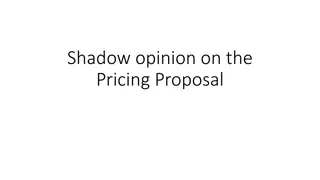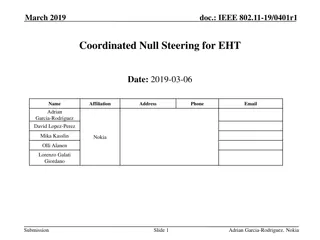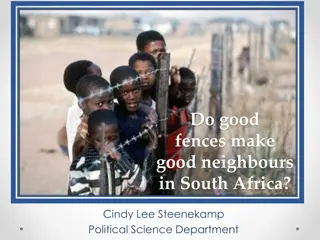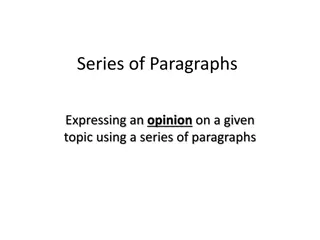Steering Opinion Dynamics Through Control of Social Networks
Understanding the dynamics of opinion formation and control in social networks is a critical area of research. This study, supervised by Susana Gomes and Marie-Therese Wolfram, explores the manipulation of collective behavior through various models including ODE, agent-based, and stochastic analysis. It delves into the interaction of individual opinions within populations and the utilization of control theory to influence consensus towards a target opinion. The research also investigates the role of social networks in shaping opinions and the application of control strategies to steer group behavior effectively.
Download Presentation

Please find below an Image/Link to download the presentation.
The content on the website is provided AS IS for your information and personal use only. It may not be sold, licensed, or shared on other websites without obtaining consent from the author.If you encounter any issues during the download, it is possible that the publisher has removed the file from their server.
You are allowed to download the files provided on this website for personal or commercial use, subject to the condition that they are used lawfully. All files are the property of their respective owners.
The content on the website is provided AS IS for your information and personal use only. It may not be sold, licensed, or shared on other websites without obtaining consent from the author.
E N D
Presentation Transcript
Steering opinion dynamics through control of social networks Andrew Nugent Supervised by Susana Gomes and Marie-Therese Wolfram
1. Opinion Dynamics Interacting particle system Collective behaviour Collective optimisation ODE models Agent-based models SDE models Stochastic analysis Control theory Network science PDE models Kinetic theory
1. Opinion Dynamics Interacting particle system Collective behaviour Collective optimisation ODE models Agent-based models SDE models Stochastic analysis Control theory Network science PDE models Kinetic theory
1. Opinion Dynamics Individual s opinion Interaction function Population size
3. Control theory Goal: For given initial conditions, find a control that brings the whole population to consensusat a preselected target opinion x*.
3. Control theory Goal: For given initial conditions, find a control that brings the whole population to consensusat a preselected target opinion x*.
3. Control theory Goal: For given initial conditions, find a control that brings the whole population to consensusat a preselected target opinion x*.
4. Controllability 1. For what combination of initial conditions and targets does such a control exist? 2. If it exists, how do we find it? 3. If we can find such a control, how well does it work? 4. If we can't find such a control, how close can we get?
4. Controllability Problem 1: Opinion fragmentation prevents consensus. Problem 2: The target opinion is not inside the opinion interval.
4. Controllability Proposition: If the population reaches consensus and the target opinion stays inside the range of opinions, the population will reach consensus at the target. Which means: These two problems are essentially the only two problems.
4. Controllability Proposition: If the population reaches consensus and the target opinion stays inside the range of opinions, the population will reach consensus at the target. Which means: These two problems are essentially the only two problems. When can we guarantee that the population reaches consensus?
4. Controllability Proposition: If the population reaches consensus and the target opinion stays inside the range of opinions, the population will reach consensus at the target. Which means: These two problems are essentially the only two problems. When can we guarantee that the population reaches consensus? Remember that example from earlier?
4. Controllability Lemma (paraphrased): By removing all edges connecting an individual to the rest of the population as quickly as possible, we can limit their overall opinion change. Corollary (paraphrased): If the control acts sufficiently quickly, we can prevent individuals crossing over the target opinion.
4. Controllability Proposition: If the population reaches consensus and the target opinion stays inside the range of opinions, the population will reach consensus at the target. Which means: These two problems are essentially the only two problems. Corollary derived from worst-case scenario. Existing consensus results.
4. Controllability Theorem (paraphrased): Assume the following The target opinion is in the interior of the initial opinions. The initial opinions are not already clustered. The control can create and remove edges anywhere within the network. Then, if the control acts sufficiently quickly, consensus can be achieved at the desired target opinion.
4. Controllability Theorem (paraphrased): Assume the following The target opinion is in the interior of the initial opinions. The initial opinions are not already clustered. The control can create and remove edges anywhere within the network. Then, if the control acts sufficiently quickly, consensus can be achieved at the desired target opinion.
Summary 1. Opinion Dynamics 2. Social networks 3. Control theory 4. Controllability
Steering opinion dynamics through control of social networks Andrew Nugent Supervised by Susana Gomes and Marie-Therese Wolfram























